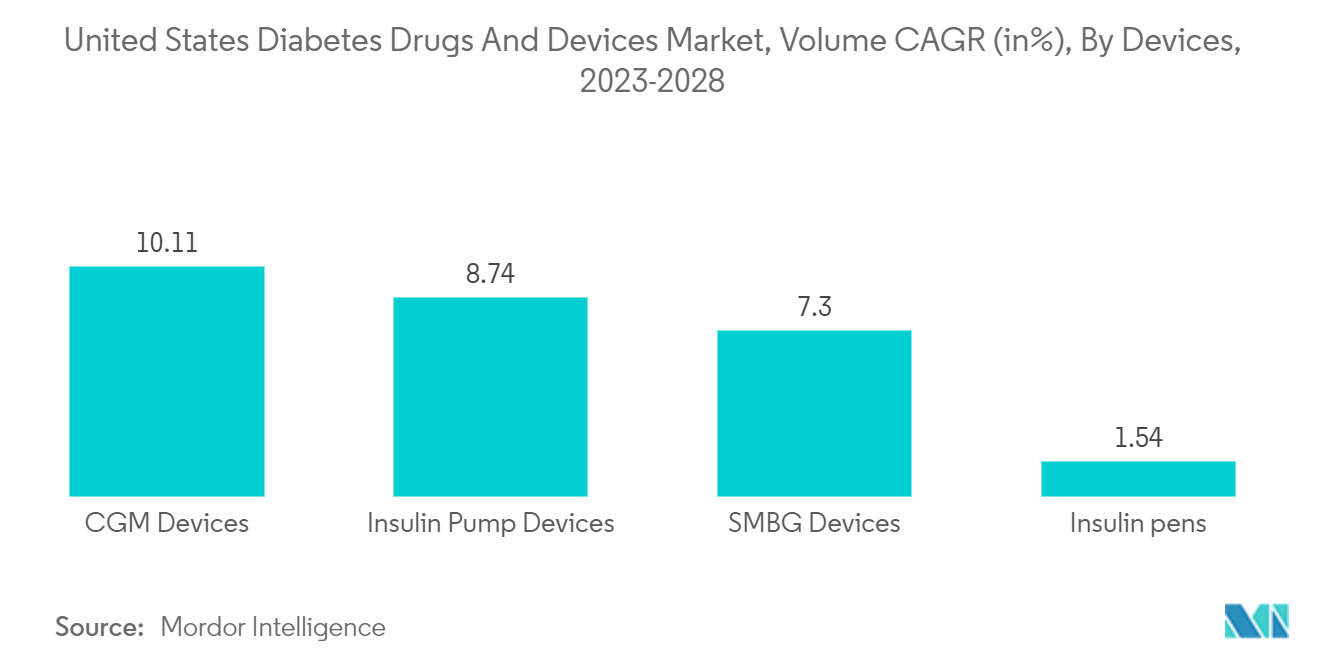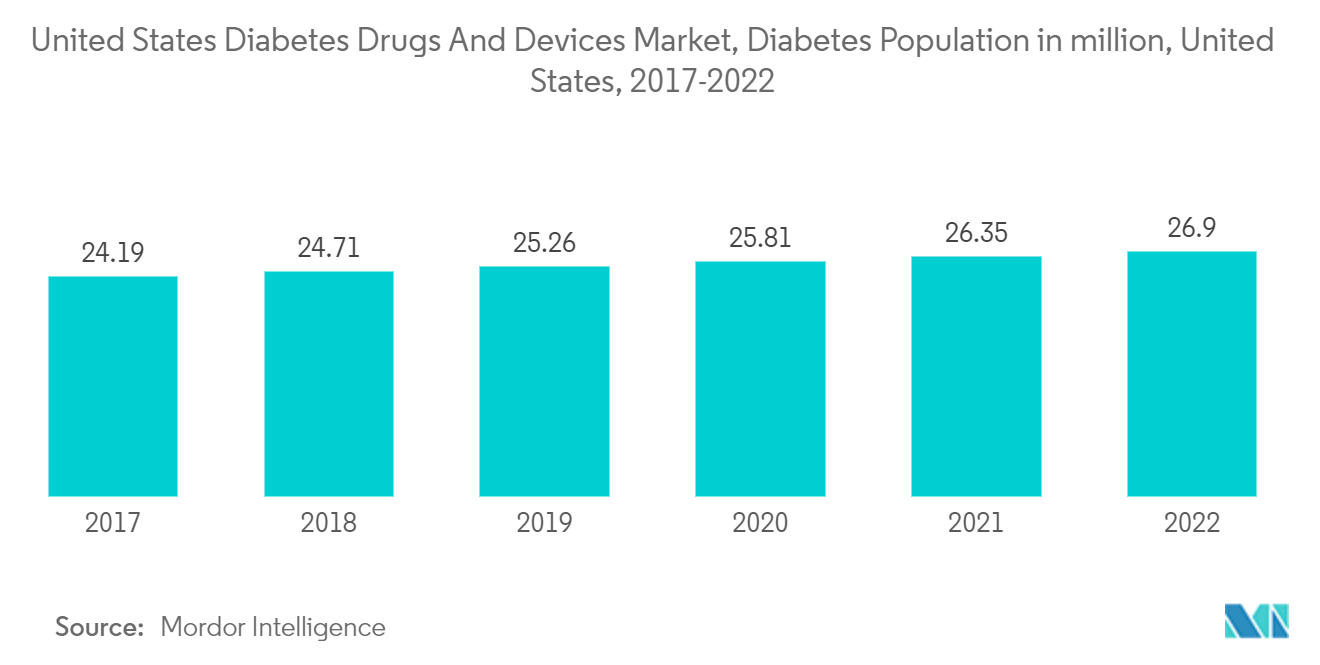Market Trends of US Diabetes Drugs And Devices Industry
Continuous Glucose Monitoring Segment is Expected to Witness Highest Growth Rate Over the Forecast Period
The continuous blood glucose monitoring segment recorded revenues of over USD 2 billion this year and is expected to grow at a compound annual growth rate (CAGR) of over 9% during the forecast period. Continuous glucose monitoring sensors use glucose oxidase to measure blood sugar levels. Glucose oxidase converts glucose to hydrogen peroxidase, which reacts with platinum in the sensor to send an electrical signal to a transmitter. The sensor is the most important part of any continuous blood glucose monitoring device. Technological advances in improving sensor accuracy are expected to drive the growth of the segment during the forecast period.
The novel coronavirus disease (COVID-19) pandemic has highlighted the need for good glycaemic control in diabetic patients. This is primarily because most observational studies report that poorly controlled diabetes increases the risk of hospitalization and death from viral disease. The frequency of monitoring blood glucose levels depends on the type of diabetes and is different for each patient. Patients with type 1 diabetes should have their blood sugar checked regularly to monitor their blood sugar levels and adjust their insulin dosage accordingly.
CGM device now provides blood glucose patterns and trends compared to routine blood glucose monitoring at set intervals. In addition, current continuous blood glucose monitors can retroactively display blood glucose trends by downloading data or providing real-time images of blood glucose levels via the receiver display.
CGM use in patients with type 1 diabetes is very low compared to patients with type 2 diabetes. However, people with type 1 diabetes spend almost twice as much on these devices as people with type 2 diabetes. The latest CGM models, Abbott Freestyle Libre and Dexcom G6, have overcome many technical obstacles. However, patients with type 2 diabetes have not adopted CGM as widely as possible due to its high cost and uncertain need and efficacy. Also, to help ease the cost burden for diabetics in the United States, Abbott has introduced a new, cheaper category (2 sensors, each lasting 14 days) that costs about $75-$150 per month. With the advent of new technologies such as mobile phone integration, continuous blood glucose monitoring devices are becoming increasingly cheaper, which is expected to drive the growth of the segment during the forecast period.

Rising diabetes prevalence in United States driving the market in the forecast year
In the United States, the prevalence of diabetes has increased dramatically over the past two decades due to rising obesity and lifestyle changes. Diabetes is one of the fastest-growing chronic diseases in the United States. About 1.75 million Americans are diagnosed with diabetes each year. The country also has the highest number of obese people, which is the main cause of type 2 diabetes. North America remained the largest market for insulin drugs, mainly due to high demand from the United States.
Diabetes drugs are drugs designed to stabilize and control blood sugar levels in people with diabetes. Antidiabetic drugs are often used to treat diabetes. Diabetes drugs have become potential candidates for treating diabetic patients affected by SARS-CoV-2 infection during the novel coronavirus disease (COVID-19) pandemic. In North America, as of April 2022, the United States had the highest number of new coronavirus infections with about 82 million people and the highest death rate. The pandemic has improved remote care for patients and providers, removing many long-standing regulatory barriers.
In July 2022, Zydus Lifesciences announced that it received final approval from the U.S. Food and Drug Administration to commercialize multi-strength tablets of empagliflozin and metformin hydrochloride. Empagliflozin and metformin hydrochloride tablets are used with proper diet and exercise to improve glycaemic control in adults with type 2 diabetes. It is also used to reduce the risk of cardiovascular death in patients with type 2 diabetes and pre-existing cardiovascular disease.
Several innovations have been launched in the United States by startups such as Glooko, OneDrop, Verily, Vacate, Insulet, Noom, Bigfoot Biomedical, Virta Health, Diabeloop, and Orgenesis. As obesity becomes more prevalent due to reduced physical activity, unhealthy diet, and other lifestyle factors, the market for diabetes treatment devices is expected to witness steady growth in the coming years. As people's awareness of advanced diabetes devices increases, so does their adaptability to diabetes devices. Leading manufacturers focus on technological innovation and the development of advanced products in order to capture a large market share. From insulin injections to insulin pumps, insulin delivery system technology has come a long way.
Technological innovations and advances have brought many conveniences to blood glucose measurement. Abbott and Dexcom have received FDA approval to use continuous blood glucose monitoring in people affected by the coronavirus in U.S. hospitals. Dexcom began shipping his CGM to hospitals in April 2020. The company plans to produce 100,000 sensors at a low cost for hospitals. The company plans to donate 10,000 phones and CGM readers to hospitals to scan those sensors. Therefore, the market under study is expected to grow during the analysis period due to the increasing prevalence of diabetes.



